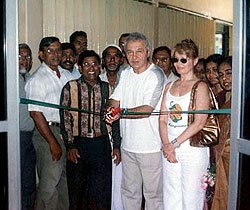American Corner info centre established
An Information Centre (Library) of the Embassy of the United States of America, called American Corner, has been established at the South Eastern University of Sri Lanka in Oluvil.
A gift of the American Government, the Centre materialized from the efforts of the Vice Chancellor of the University, Dr. A.G. Hussain Ismail, and was declared open at a ribbon-cutting ceremony by James F. Entwistle, Charge d'Affairs of the US Embassy. Public Affairs Officer Phillip A. Fryne, Cultural Affairs Officer Angela L.Gemza, and Director of Information Deepali Talagala were also present.
The Corner will provide, and routinely update, print and electronic collections on themes related to: business, economics, law, politics, American studies, English as a second language (ESL), and more. The American Information Resource Centre, along with the Library of the South Eastern University of Sri Lanka, will also select and purchase new books, periodicals, and electronic publications for inclusion in the American Corners Collection.
This facility will provide work stations for accessing the American Corner?s' electronic collections and the internet, viewing stations for its video collections, a photocopier, and resources for maintaining the collections and equipment. The US Embassy, working with Library's, will also provide training to the staff of the library overseeing the operations of the American Corner, so as to ensure their continual professional growth.
At the conclusion of the ceremony, and in memory of their visit to the University, the Vice Chancellor, Dr. Hussain Ismail, presented mementos to the Charge d?'Affairs and his team. This was followed by the signing of the memorandum of understanding (MOU).
Speaking at this occasion, Charge d'Affairs Entwistle said that the Corner would strengthen the relationship between the people of Sri Lanka and the Unites States. Dr. Isamil thanked the Charge d'Affairs and the Government of the USA for their generosity and assured them that this gift would serve the entire population of the region. Acting Librarian M.M. Rifaudeen proposed the vote of thanks.
 Above: Charge d'Affairs of the US Embassy, James F. Entwistle, and Vice-Chancellor of the South Eastern University of Sri Lanka, Dr. A.G. Hussain Ismail, sign the MOU prior to opening "American Corner".
Above: Charge d'Affairs of the US Embassy, James F. Entwistle, and Vice-Chancellor of the South Eastern University of Sri Lanka, Dr. A.G. Hussain Ismail, sign the MOU prior to opening "American Corner".
